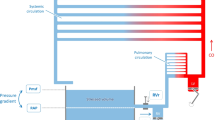Abstract
Guyton's theory on venous return, implying a linear relationship between blood flow and central venous pressure, was tested in an intact circulation after thoracotomy and airtight chest closure. In eleven Yorkshire pigs (approx. 10 kg) we measured flow in the pulmonary artery and aorta and pressure in the central veins and aorta during pentobarbital anesthesia and mechanical ventilation. To change central venous pressure different lung volumes were randomly applied at intervals of 5 min in a series of inspiratory hold procedures of 7.2 s. During these short periods hemodynamic steady state circumstances were met without involvement of cardiovascular control mechanisms.
We confirmed the linear relationship between venous return and central venous pressure and derived mean systemic filling pressure from the regression equation. Mean systemic filling pressure was on average 10.5±2.3 (SD) mm Hg.
The time dependent changes during the inspiratory hold procedure showed that the increase in central venous pressure was the primarily dependent variable, followed by a decrease in venous return and right ventricular output. After a delay of 2–4 heart beats also a decrease in left ventricular output and aortic pressure occurred. Subsequently, the lower venous return during inspiratory hold was mainly sustained by the lower aortic pressure, but nevertheless fulfilled the linear relationship mentioned above.
For analysis of flow and pressure changes in the systemic circulation during changes of central venous pressure a tube of constant flow resistance was used as a conceptual model. Consequently, the point where mean systemic filling pressure exists during normal flow conditions was predicted at a characteristic location in the peripheral venous system. Downstream from this point blood pressure will rise and vessel capacity will be filled up during increases in central emptying vessel capacity partially.
Similar content being viewed by others
References
Badeer HS (1981) Cardiac output and venous return as interdependent and independent variables. Cardiology 67:65–72
Bradley SE (1963) The hepatic circulation. In: Hamilton WF (ed) Handbook of physiology, section 2, Circulation, vol II, chapter 41. American Physiological Society, Washington, p 1405.
Caldini P, Permutt S, Waddell JA, Riley RL (1974) Effect of epinephrine on pressure, flow, and volume relationships in the systemic circulation of dogs. Circ Res 34:606–623
Charlier AA, Jaumin PM, Pouleur H (1974) Circulatory effects of deep inspirations, blocked expirations and positive pressure inflations at equal transpulmonary pressures in conscious dogs. J Physiol 241:589–605
Donald ED, Edis AJ (1971) Comparison of aortic and carotid baroreflexes in the dog. J Physiol 215:521–538
Drees JA, Rothe CF (1974) Reflex venoconstriction and capacity vessel pressure-volume relationships in dogs. Circ Res 34:360–373
Grauwiler J (1965) Herz und Kreislauf der Säugetiere. Birkhäuser Verlag, Basel
Guyton AC (1981) Textbook of medical physiology, 6th edn.: p 216 and p 282–284. W. B. Saunders Company, Philadelphia
Guyton AC (1981) Textbook of medical physiology, 6th edn.: p 220. W. B. Saunders Company, Philadelphia
Guyton AC, Lindsey AW, Kaufmann BN (1955) Effect of mean circulatory filling pressure and other peripheral circulatory factors on cardiac output. Am J Physiol 180:463–468
Guyton AC, Lindsey AW, Abernathy B, Richardson T (1957) Venous return at various right atrial pressure and the normal venous return curve. Am J Physiol 189:609–615
Guyton AC, Jones CE, Coleman TG (1973) Circulatory physiology: Cardiac output and its regulation. W. B. Saunders Company, Philadelphia
Hall SV, Johnson EE, Hedley-Whyte J (1974) Renal hemodynamics and function with continuous positive-pressure ventilation in dogs. Anesthesiology 41:452–461
Harlan SC, Smith EE, Richardson TQ (1967) Pressure-volume curves of systemic and pulmonary circuit. Am J Physiol 213:1499–1503
Hoffman JIE, Guz A, Charlier AA, Wilcken DEL (1965) Stroke volume in conscious dogs; effect of respiration, posture, and vascular occlusion. J Appl Physiol 20:865–877
Jansen JRC, Schreuder JJ, Bogaard JM, Rooyen W van, Versprille A (1981) The thermodilution technique for the measurement of cardiac output during artificial ventilation. J Appl Physiol 51:584–591
Keele CA, Neil E, Joels N (1982) Samson Wright's applied physiology, 13th edn. Oxford University Press, Oxford, p. 66
Kumada M, Okai O, Gunji A (1971) Mean circulatory pressure in carotid sinus reflex. Jpn J Physiol 21:591–599
Landis EM, Pappenheimer JR (1963) Exchange of substances through the capillary walls. In: Hamilton WF (ed) Handbook of physiology, section 2, Circulaton, vol II. chapter 29. American Physiological Society, Washington p 961
Levy MN (1979) The cardiac and vascular factors that determine systemic bloow flow. Circ Res 44:739–747
Marquez JM, Douglas ME, Downs JB, Wu WH, Mantini EL, Kuck EJ, Calderwood HW (1979) Renal function and cardiovascular responses during positive airway pressure. Anesthesiology 50:393–398
Mitzner W (1974) Hepatic outflow resistance, sinusoid pressure, and the vascular waterfall. Am J Physiol 227:513–519
Morgan BC, Martin WE, Hornbein TF, Crawford EW, Guntheroth WG (1966) Hemodynamic effects of intermittent positive pressure respiration. Anesthesiology 27:584–590
Pinsky MR (1984) Instantaneous venous return curves in an intact canine preparation. J Appl Physiol: Respir Environ Exercise Physiol 56:765–771
Priebe HJ, Heimann JC, Hedley-Whyte J (1981) Mechanisms of renal dysfunction during positive end-expiratory pressure ventilation. J Appl Physiol: Respir Environ Exercise Physiol 50:643–649
Scher AM, Young AC (1963) Servoanalysis of carotid sinus reflex effects on peripheral resistance. Circ Res 12:152–162
Schreuder JJ, Jansen JRC, Bogaard JM, Versprille A (1982) Hemodynamic effects of positive end-expiratory pressure applied as a ramp. J Appl Physiol 53:1239–1247
Author information
Authors and Affiliations
Rights and permissions
About this article
Cite this article
Versprille, A., Jansen, J.R.C., Drop, A. et al. Mean systemic filling pressure as a characteristic pressure for venous return. Pflugers Arch. 405, 226–233 (1985). https://doi.org/10.1007/BF00582565
Received:
Accepted:
Issue Date:
DOI: https://doi.org/10.1007/BF00582565




